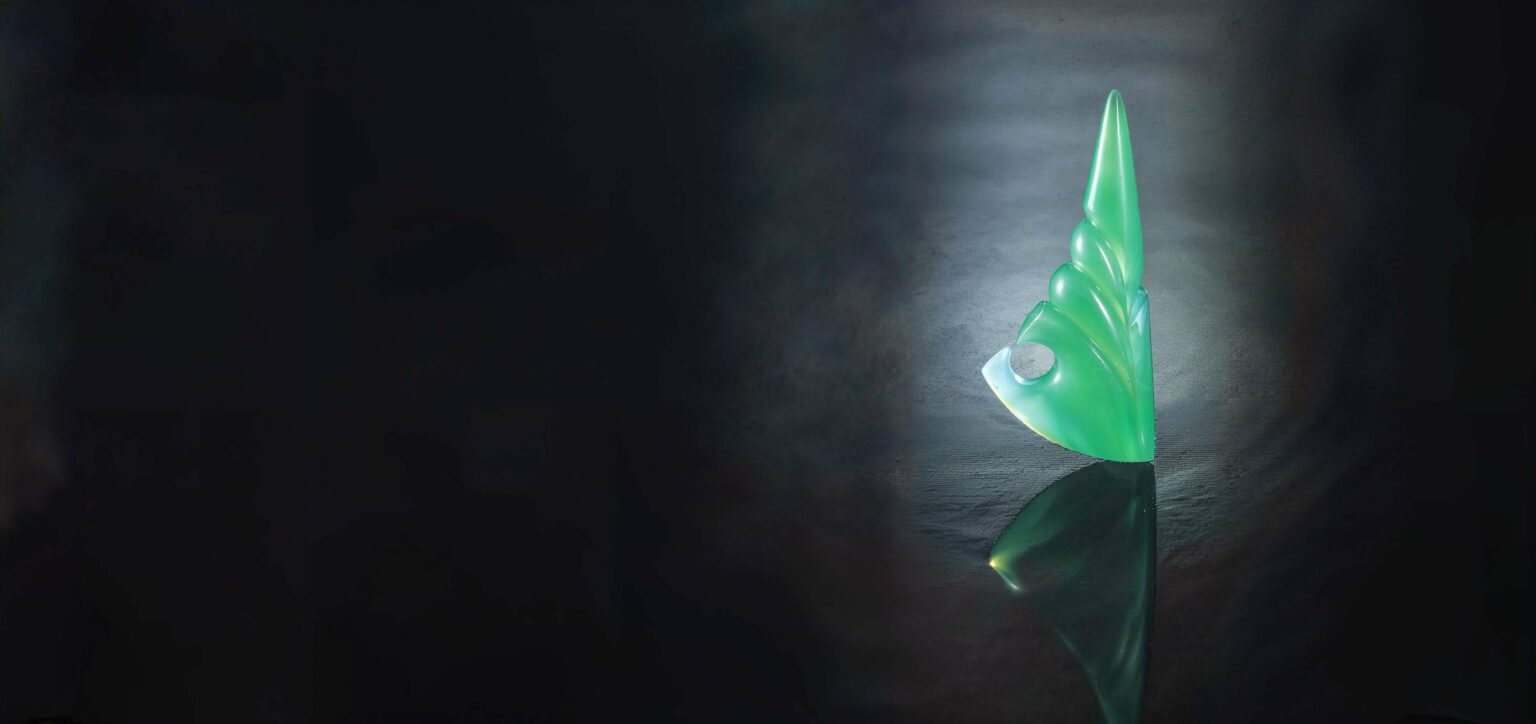Royal patronage has long been the cornerstone of fame for gems. Where would a sales pitch for emerald be without mention of Cleopatra? And look what talk of Nero does for amber and opal.
Well, now that chrysoprase, the lovely green quartz with hues reminiscent of Prell shampoo and Granny Smith apples, is making its biggest noise in nearly two centuries, name droppers will be delighted to know this gem’s greatest patron was as royal as royal gets.
Does the name “Frederick the Great” ring a bell? Born in 1712 and king of Prussia from 1740 until his death in 1786, this flute-playing sovereign commissioned works by Bach and was a friend of Voltaire. Addicted to the arts, he adorned his opulent palace at Potsdam, named Sans Souci, with objects manufactured in whole or part of chrysoprase. All of the material for these works (among them, two all-chrysoprase tables) came from a find in what is now Poland but was then Silesia.
According to a lone-studied article on European chrysoprase by Si and Ann Frazier in the February 1992 issue of Lapidary Journal, Frederick preferred this quartz to any other gem. “His favorite ring was … set with a large chrysoprase surrounded by 15 brilliants (presumably diamonds). Reportedly, Frederick never took this ring off. He also carried a walking stick … with a knob of chrysoprase.”
Of course, Frederick wasn’t the first major mover to develop a fondness for chrysoprase. Since the gem figures prominently in some majestic Czech churches built in the 14th century, it can be assumed that chrysoprase was popular whenever mined in quantity. But Frederick’s fancy stands out.
Amazingly, European chrysoprase was rarely a match for that discovered at Marlborough Creek in Queensland, Australia, in 1965. It is this deeper-toned, more saturate-color chrysoprase that is responsible for the revival of interest in this gem in the past few years. Considered at its best a jadeite look-alike, Queensland chrysoprase is now one of the most significant of Australia’s many gem exports. But rapidly accelerating demand is sending prices to new highs and crimping supplies of fine goods.
By the Jarful
Because of all the attention it is receiving, chrysoprase may be close to achieving the kind of acclaim it enjoyed during its last great vogue between 1740, when it was rediscovered, and 1830, when supplies were once again exhausted. In 1820, mineralogist Robert Jameson, quoted in the Lapidary Journal article, wrote that chrysoprase rings with “semi-transparent … pure apple-green color,” stones were selling at “10 to 20 guineas” (a guinea is worth one pound and one shilling). This may not sound like much, but since, says The Economist, an 1820 British pound would have had buying power equivalent to $64 today, it means a minimum of $650 to $1,300 retail for a chrysoprase ring at current exchange rates. That’s roughly what a 14k-gold men’s ring with a standard-size chrysoprase cabochon retails for today.
No wonder quartz specialist Mike Michael Randall of Crystal Reflections, San Anselmo, Calif., say chrysoprase is undergoing “its greatest surge of popularity in history.” If nothing else, spiraling prices for this gem suggest that it is galloping down the comeback trail.
“A decade ago, you could buy jars with up to 200 grams of high-quality chrysoprase rough for $5 at most any gem and mineral show,” Randall notes. “Today the same material costs $2 to $4 a gram and you sure can’t buy it in jars. Chrysoprase has gone from being a rock to a gem.”
Again. Now that it has regained full gem status, decent chrysoprase in cabochon form will cost jewelers anywhere from $8 to $12 per carat, with exceptional stones commanding up to $50 per carat.
How Dry I Am
Although chrysoprase comes from Tanzania and Brazil, Australia produces the best and by far the most of this breed. At the 1991 International Gemological Symposium, Brisbane gemologist Graham Brown estimated that Queensland currently supplies 85% of the world’s chrysoprase. He also told the gathering that Australia can support current demand for anywhere from 20 to 40 more years.
Lapidaries, designers and manufacturers would love to rely permanently on Australia for chrysoprase. From a standpoint of beauty, this material is unexcelled. While Brazilian stones tend to a murky olive-green, and Tanzanian stones a lighter yellowish-green, Australian goods run a pleasant color gamut from sweet apple to a medium jade-green. Often in fact, you will hear the stone talked about as an affordable alternative to jadeite.
The strong color likeness between chrysoprase and jadeite helps to explain why Chinese dealers, the world’s main suppliers of fine jade, are the biggest buyers of Queensland chrysoprase. Ever since the discovery of chrysoprase in Australia, the Chinese have been amassing huge stockpiles of this gem, first in Hong Kong, then Thailand, where many moved when Great Britain announced it would turn this is land-protectorate over to Communist China in 1997. And now that chrysoprase has caught on with U.S. jewelry designers, America—in particular, California—has become the second largest stockpiler of this gem.
Beauty alone doesn’t explain the hyperactive market in Australian chrysoprase. Queensland material is more resistant to this gem’s one drawback—fading in sunlight and heat- because it is more water-retentive.
Fading occurs when dehydration robs stones of their coloring agent, pimelite, a silicate. According to the Fraziers, pimelite has a layered structure that readily traps or loses moisture. As stones dry out, they lose translucency and luster. To restore these attributes, Randall advises leaving stones in wet cotton or taking a bath wearing one’s chrysoprase jewelry.
Before Australia became the dominant source of chrysoprase, dealers compensated for the gem’s scarcity by staining colorless quartz green, using either nickel salts or chromium salts (both greening agents). Despite the abundance of chrysoprase today, stones with ersatz green remain an annoyance and should be guarded against as natural-color stones become more popular and expensive. According to Robert Webster’s “Gems,” the most common simulated greens are produced with chromium salts. These can be detected with a Chelsea filter (stained stones show a “brownish-red residual color”) and a spectroscope (look for “three vague lines in the red part of the spectrum”).
Please note: this profile was originally published in 1992 in Modern Jeweler’s ‘Gem Profiles/2: The Second 60’, written by David Federman with photographs by Tino Hammid.
The 22.50-carat chrysoprase shown in the header image is courtesy of Michael Dyber, Rumney, N.H.






